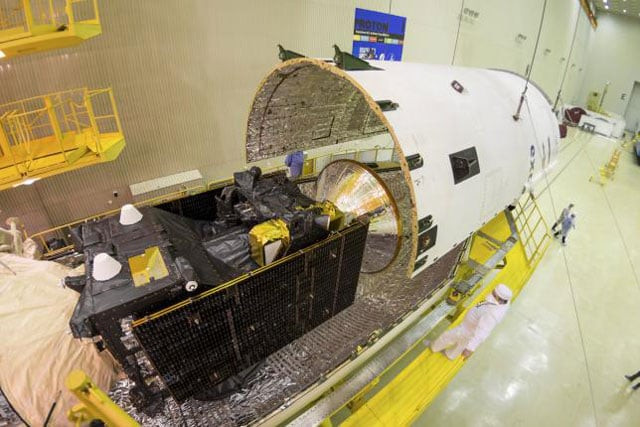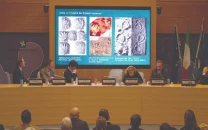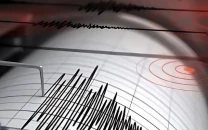Spacecraft to seek life on Mars in European-led mission
The mission will carry atmospheric probe and a lander to test technologies needed for a rover due to follow in 2018

The ExoMars 2016 spacecraft composite, comprised of the Trace Gas Orbiter and Schiaparelli, is seen during the encapsulation within the launcher fairing at the Baikonur cosmodrome, Kazakhstan, in this handout photo released by European Space Agency (ESA) on March 2, 2016. PHOTO: REUTERS
The craft, part of the European-Russian ExoMars programme, is to lift off from the Baikonur spaceport in Kazakhstan on board a Proton rocket at 5:31 A.M. EDT (0931 GMT) on Monday, starting a seven-month journey through space.
It will carry an atmospheric probe that will study trace gases, such as methane, around Mars as well as a lander that will test technologies needed for a rover due to follow in 2018.
Mars robot launch now scheduled for May 2018: NASA
US space agency NASA's Mars rover Curiosity in late 2014 found spurts of methane gas in the planet's atmosphere, a chemical that on Earth is strongly tied to life.
Scientists believe the methane could stem from micro-organisms, called methanogenes, that either became extinct millions of years ago and left gas frozen below the planet's surface, or that some methane-producing organisms still survive.
"Proving that life exists or has existed on Mars would show that Earth is not unique in terms of having life on it," Rolf de Groot, head of the European Space Agency's (ESA) Robotic Exploration Coordination Office, told Reuters.
"That would make it much more likely that there are other places in the universe that also have life," he added.
NASA reveals Apollo astronauts heard unexplained ‘music’ on far side of moon
Another explanation for the methane in Mars's atmosphere could be that it is produced by geological phenomena, like the oxidation of iron.
The second part of the ExoMars mission in 2018 will deliver a European rover to the surface of Mars. It will be the first with the ability to both move across the planet's surface and drill into the ground to collect and analyse samples.
"The radiation from space destroys all the biological material. If you go two metres into the ground you may be able to find places that were protected (from radiation)," de Groot said.
Landing on Mars is a notoriously difficult task that has bedevilled nearly all of Russia's previous efforts and has given NASA trouble as well. The United States currently has two operational rovers on Mars, Curiosity and Opportunity.
The ExoMars 2016 mission is led by ESA, with Russia's Roscosmos supplying the launcher and two of the four scientific instruments on the trace gas orbiter. The prime contractor is Thales Alenia Space, a joint venture between Thales and Finmeccanica.
Mars water find boosts quest for extra-terrestrial life
The cost of the ExoMars mission to ESA, including the second part due in 2018, is expected to be about 1.3 billion euros ($1.4 billion). Russia's contribution comes on top of that.
In 2018, NASA also plans to launch a Mars spacecraft, a satellite known as InSight and designed to study the deep interior of Mars, the U.S. agency said this week.



















COMMENTS
Comments are moderated and generally will be posted if they are on-topic and not abusive.
For more information, please see our Comments FAQ